Worm Gear Shaft
A worm gear shaft is the shaft that the worm gear is mounted on. It is typically made of strong and durable material, such as steel, to withstand the high torque and wear that is associated with worm gears. The worm gear shaft is usually supported by bearings to reduce friction and vibration. The worm gear shaft is an important part of the worm gear assembly. It provides the support and alignment that the worm gear needs to operate properly. The size of the worm gear shaft is determined by the size of the worm gear and the amount of torque that the worm gear needs to transmit. The worm gear shaft must be strong enough to withstand the torque without bending or breaking.
Worm Gear Shaft
Worm Gear Shaft (Worm Gear Drive Shaft) Customized Worm Shaft
A worm gear shaft is the shaft mounts on the worm gear. It is typically making of strong and durable material, such as steel, to withstand the high torque and wear. The shaft is usually supported by bearings to reduce friction and vibration. The shaft is an important part of the worm gear assembly. It provides the support and alignment that the worm gear needs to operate properly. The gear shaft is also responsible for transmitting the power from the motor to the gear.
There are two main types: straight and tapered. Straight shafts are the most common type. They are used in applications where the worm gear needs to rotate in a straight line. Tapered worm gear shafts are used in applications where the worm gear needs to rotate in a curved line.
The size is determined by the size of the worm gear and the amount of torque that the worm gear needs to transmit. The worm gear shaft must be strong enough to withstand the torque without bending or breaking. The drive shaft is an important part of the worm gear assembly. It provides the support, alignment, and power transmission that the worm gear needs to operate properly.
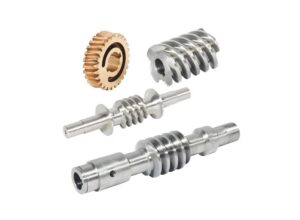 |
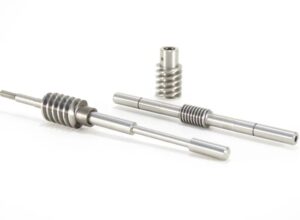 |
Specifications
| Model Number | M1,M2,M3,M4,M5,M8,M12 and etc. |
| Material | Brass, C45 steel, Stainless steel, Copper, POM, Aluminum, Alloy, and so on |
| Surface treatment | Zinc-plated, Nickel plated, Passivation, Oxidation, Anodization, Geomet, Dacromet, Black Oxide, Phosphatizing, Powder Coating, and Electrophoresis |
| Standard | ISO, DIN, ANSI, JIS, BS, and Non-standard. |
| Precision | DIN6,DIN7,DIN8,DIN9. |
| Teeth treatment | Hardened, Milled, or Ground |
| Tolerance | 0.001mm-0.01mm-0.1mm |
| Finish | shot/sandblast, heat treatment, annealing, tempering, polishing, anodizing, zinc-plated |
| Items packing | Plastic bag+Cartons Or Wooden Packing |
| Payment terms | T/T, L/C |
| Production lead time | 20 business days for the sample,25 days for the bulk |
| Samples | Sample price range from $2 to $100. sample express request paid by clients |
| Application | 1. Automatic controlling machine 2. Semi-conductor industry 3. General industry machinery 4. Medical equipment 5. Solar energy equipment 6. Machine tool 7. Parking system 8. High-speed rail and aviation transportation equipment, etc. |
Design Features
The design features of a worm gear shaft are determined by the following factors:
- The size and type of worm gear
- The amount of torque that the worm gear needs to transmit
- The operating environment
- The desired cost
The following are some of the design features that are typically considered when designing a worm gear shaft:
- Material: The worm gear shaft is typically made of strong and durable material, such as steel, to withstand the high torque and wear that is associated with worm gears.
- Size: The size of the worm gear shaft is determined by the size of the worm gear and the amount of torque that the worm gear needs to transmit. The worm gear shaft must be strong enough to withstand the torque without bending or breaking.
- Shape: The shape of the worm gear shaft can be straight or tapered. Straight worm gear shafts are the most common type. They are used in applications where the worm gear needs to rotate in a straight line. Tapered worm gear shafts are used in applications where the worm gear needs to rotate in a curved line.
- Surface finish: The surface finish of the worm gear drive shaft is important to reduce friction and wear. The surface finish can be improved by polishing or honing.
- Bearings: The worm gear shaft is typically supported by bearings to reduce friction and vibration. The type of bearings that are used depends on the operating environment and the desired cost.
The following are some of the design considerations that are typically made when designing a worm gear shaft:
-
Cost: The cost of the worm gear shaft is determined by the material, size, shape, surface finish, and bearings. The desired cost is an important factor in the design of the worm gear shaft.
-
Operating environment: The operating environment can affect the design of the worm gear shaft. For example, if the worm gear shaft is exposed to a corrosive environment, the material of the worm gear shaft may need to be changed.
-
Reliability: The worm gear shaft should be designed to be reliable. This can be done by using high-quality materials and by ensuring that the worm gear shaft is properly lubricated.
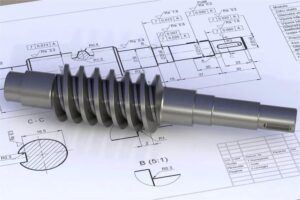 |
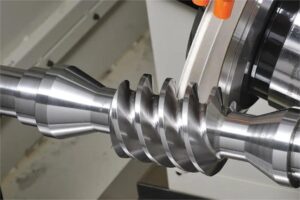 |
Design Process
The design of a worm gear shaft is a complex process that involves many factors. The following are some of the steps that are typically involved in the design of a worm gear shaft:
- Determine the size and type of worm gear.
- Determine the amount of torque that the worm gear needs to transmit.
- Consider the operating environment.
- Consider the desired cost.
- Select the material, size, shape, surface finish, and bearings.
- Verify the design.
- Manufacture the worm gear shaft.
The design of a worm gear shaft is an important step in the development of a worm gear system. The proper design of the worm gear shaft can ensure that the worm gear system operates efficiently and reliably.
Applications
Worm gear shafts are used in a variety of applications, including:
(1) Machine tools: Worm gear shafts are used in machine tools to transmit power from the motor to the cutting tool. The high torque capacity of worm gear shafts allows them to handle the high loads that are associated with machining.
(2) Elevators: Worm gear shafts are used in elevators to raise and lower the elevator car. The compact design of worm gear shafts makes them ideal for use in elevators, which are often space-constrained.
(3) Conveyors: Worm gear shafts are used in conveyors to move materials from one place to another. The high efficiency of worm gear shafts allows them to move materials with little power consumption.
(4) Robotics: Worm gear shafts are used in robotics to control the movement of robotic arms. The compact design and high torque capacity of worm gear shafts makes them ideal for use in robotics.
(5) Textile machinery: Worm gear shafts are used in textile machinery to control the movement of the fabric. The high efficiency of worm gear shafts allows them to move fabric with little power consumption.
(6) Food processing machinery: Worm gear shafts are used in food processing machinery to control the movement of food products. The high efficiency of worm drive shafts allows them to move food products with little power consumption.
(7) Packaging machinery: Worm gear shafts are used in packaging machinery to control the movement of packaging materials. The high efficiency of worm gear shafts allows them to move packaging materials with little power consumption.
(8) Wind turbines: Worm gear shafts are used in wind turbines to transmit power from the rotor to the generator. The high torque capacity of worm gear drive shafts allows them to handle the high loads that are associated with wind turbines.
(9) Solar panels: Worm gear shafts are used in solar panels to track the sun. The compact design of worm gear shafts makes them ideal for use in solar panels, which are often space-constrained.
Worm gear shafts are an important part of many machines and devices. They provide the support, alignment, and power transmission that these machines need to operate properly.
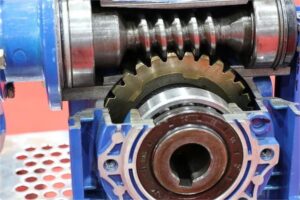 |
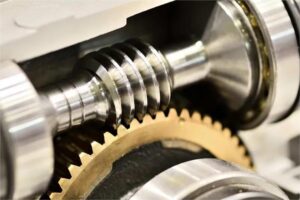 |
Lubrication and Maintenance
Worm gear shafts require regular lubrication and maintenance to ensure that they operate properly and last for a long time. The type of lubricant used and the frequency of lubrication will depend on the application and the environment in which the worm gear shaft is used.
In general, worm gear shafts should be lubricated with high-quality oil or grease. The oil or grease should be applied to the worm gear shaft and the bearings. The frequency of lubrication will depend on the application and the environment in which the worm gear shaft is used. In general, worm gear shafts should be lubricated every 1,000 to 2,000 hours of operation.
In addition to lubrication, worm gear shafts should also be inspected regularly for signs of wear and tear. The worm gear shaft should be checked for cracks, dents, and other damage. The bearings should also be checked for wear and tear. If any signs of wear or tear are found, the worm gear shaft should be repaired or replaced.
Proper lubrication and maintenance of worm gear shafts can help to extend their lifespan and improve their performance. By following these simple steps, you can help to ensure that your worm gear shafts operate properly and last for a long time.
Here are some additional tips for lubricating and maintaining worm gear shafts:
-
Use the correct type of lubricant. The type of lubricant used will depend on the application and the environment in which the worm gear shaft is used. Consult the manufacturer’s recommendations for the correct type of lubricant.
-
Apply the lubricant correctly. The lubricant should be applied to the worm gear shaft and the bearings. The lubricant should be applied evenly to all surfaces.
-
Lubricate the worm gear shaft regularly. The frequency of lubrication will depend on the application and the environment in which the worm gear shaft is used. In general, worm gear shafts should be lubricated every 1,000 to 2,000 hours of operation.
-
Inspect the worm gear shaft regularly. The worm gear shaft should be checked for cracks, dents, and other damage. The bearings should also be checked for wear and tear. If any signs of wear or tear are found, the worm gear shaft should be repaired or replaced.
By following these tips, you can help to ensure that your worm gear shafts operate properly and last for a long time.
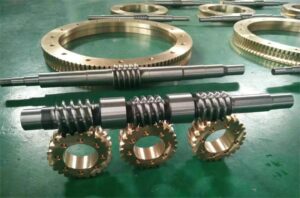 |
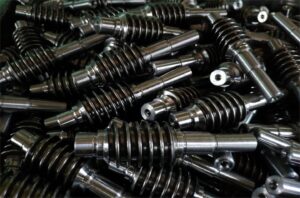 |
FAQ
Q1: What is a worm gear set?
A: A worm gear set consists of a cylindrical screw-like shaft (called the worm) and a gear wheel with teeth (called the worm wheel). When the worm rotates, it turns the worm wheel, causing it to rotate.
Q2: What are the advantages of using a worm gear shaft?
A: Worm gear shafts have several advantages, including a high gear ratio (which allows for more torque), low noise and vibration, and self-locking ability (meaning the worm gear shaft will not rotate backward).
Q3: What are the common applications of worm gear shafts?
A: Worm gear shafts are commonly used in automotive, aerospace, and industrial applications, including conveyor systems, elevators, valve actuators, and winches.
Q4: What materials are worm gear shafts made of?
A: Worm gear shafts can be made from a variety of materials, including steel, bronze, and plastic. The choice of material depends on factors such as the application, load capacity, and environmental conditions.
Q5: How do you select the right worm gear shaft for a particular application?
A: To select the right worm gear shaft, you need to consider factors such as the required gear ratio, torque capacity, speed, and environmental conditions (such as temperature and humidity). Consult with a manufacturer or supplier with experience in worm gear shafts to help you choose the right product for your application.
Q6: How do you maintain a worm gear shaft?
A: Maintenance of a worm gear shaft involves regular lubrication and inspection for wear and damage. Lubrication helps to reduce friction and wear between the worm and worm wheel, while inspection can help identify issues such as worn teeth or misalignment. Regular maintenance can help extend the life of the worm gear shaft and prevent costly downtime.

Packing Shipping Delivery
  |
 |
|
 |
 |
|
How to choose power transmissions parts and industrial products which meet our requirement
| Chains | Sprockets | Pulleys | Timing belt Pulley | V-belt Pulley |
| Sheaves | Coupings | Bush &Hub | Gear& Rack | V-Belt |
| Locking Assembly | Pulley | Gearbox | Reducer | Shaft Collar |
| Rod End Bearing | Clevis | PTO | Chain Guide | Belt Guide |
| Rubber Buffer | Chain Tensioner | PTO Drive Shafts | Universal Joints | Roller Chains |
| Conveyor Chains | V-Belts | Worm Gearbox | Helical Gear | Worm |
| Agricultural Chain | CNC Proces Parts | Casting | Stamping | |
| Powder Metallurgy | CNC Proces Parts | Casting | Stamping |
What Products Do you sell ?
We are a group of factories, give customer one stop solution of power transmission and industrial products. We are in the position to supply wide range of products, including chains, sprockets, v-belt and v-belt pulleys, timing belt and timing belt pulleys, gears, speed reducers, motors, racks, couplings, and many other parts, like locking assembly, taper bushing, Chain guide, shaft collar, torque limiter, cam clutch, universal joint, motor base and motor slide, rod end, clevis, rubber mount, etc. We make special parts according to drawings and/or samples.
How to choose a gearbox which meets our requirement?
You can refer to our catalogue to choose the gearbox or we can help to choose when you provide
the technical information of required output torque, output speed and motor parameter etc.
What information shall we give before placing a purchase order?
a) Type of the gearbox, ratio, input and output type, input flange, mounting position, and motor informationetc.
b) Housing color.
c) Purchase quantity.
d) Other special requirements.
What industries are your gearboxes being used?
Our gearboxes are widely used in the areas of textile, food processing, beverage, chemical industry,
escalator,automatic storage equipment, metallurgy, tabacco, environmental protection, logistics and etc.
What is the producing process?
Production process including raw material cutting, machine processing, grinding, accessories cleaning, assemble, cleaning, stoving, oil coating, cover pressing, testing, package.
How to control the products quality?
Combining advanced equipment and strict management, we provide high standard and quality bearings for our customers all over the world.
What is the transportation?
-If small quantity , we Suggest to send by express, such as DHL,UPS, TNT FEDEX. If large amount, by air or sea shipping.
Can we design packaging?
-Yes. Default is regular packing, and we can make customer's own packing.
Can you provide OEM service?
-Yes, we work on OEM orders. Which means size, quantity, design, packing solution, etc will depend on your requests; and your logo will be customized on our products.
Can you give me discount on Power Transmissions Parts and Industrial parts?
-Yes, of course. Pls. send me your Email, you'll get more
Q: Are You a trading company or a manufacturer?
A: We Are the factory and have our Own trading company
Q: How Can I get an offer?
A: please send US quotation information: drawings, materials, weight, quantity and requirements, we can accept PDF, ISGS, DWG, STEP file format. If you don't have the drawings, please send us the samples, we can also quote you according to your samples.
Q: What is your minimum order size?
A: it is usually 100 pieces, but a low quantity is acceptable under some special circumstances.
Q: Do you provide samples? Is it free or extra?
A: Yes, we can provide samples free of charge, but we don't pay the freight.
Q: What is the lead time for mass production?
A: honestly, it depends on the number of orders. Normally, if you don't need the tools, deposit them after 30 days or so.
Q: What if the parts don't Work?
A: we can guarantee the quality, but if it happens, please contact us immediately, take some photos, we will check the problem and solve it as soon as possible.
Q: What are your terms of payment?
A: payment is less than US $1000,100% in advance. Payment: $1000,50% wire transfer in advance, balance before shipment,Other Terms of payment are negotiable


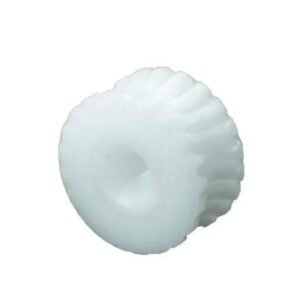
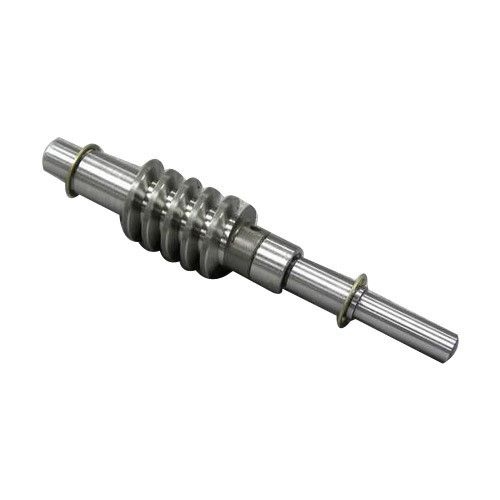
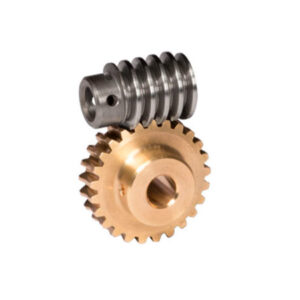
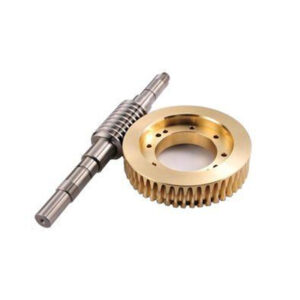
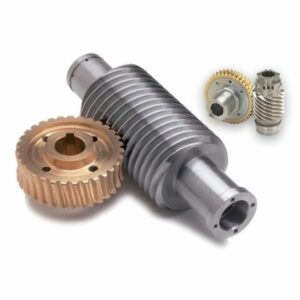
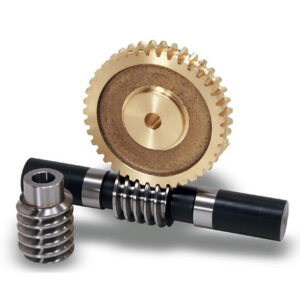
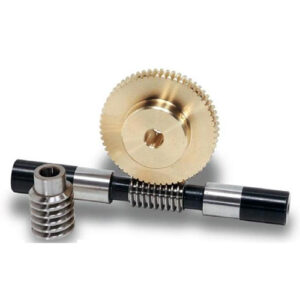
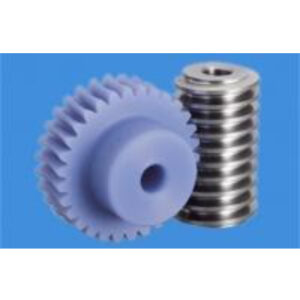
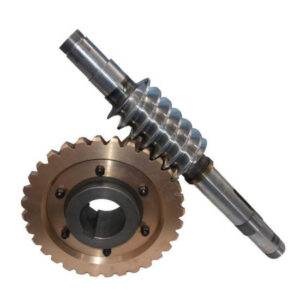
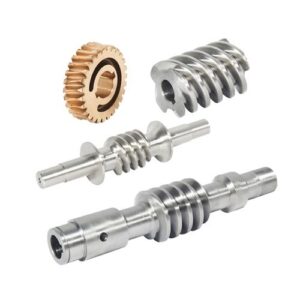
Reviews
There are no reviews yet.